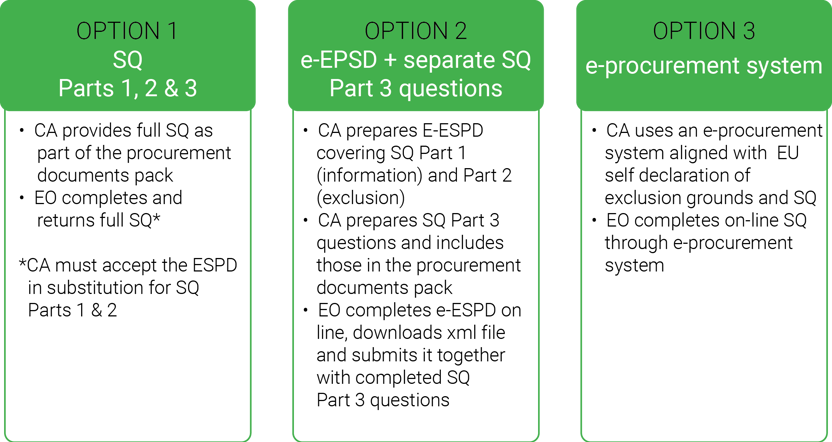14/03/2017
This is the sixth in a series of short "SQ Bytes" looking at the Selection Questionnaire (SQ) issued by the Crown Commercial Service (CCS).
SQ Byte 1 provides an overview of the structure and content of the SQ and statutory guidance.
SQ Byte 4 covers when and how you can amend the SQ.
SQ Byte 5 looks in more detail at the standard questions in Parts 1, 2 and 3 of the SQ.
This SQ Byte 6 considers the interaction between the SQ and the ESPD.
SQ Byte 7 on self-cleaning, concludes the series.
In SQ Byte 5 we considered at some specific issues on the SQ questions which have arisen in practice. In this SQ Byte 6 we look at the European Single Procurement Document (ESPD), its purpose and content and how it aligns and interacts with the ESPD.
The SQ and the new European Single Procurement Document "ESPD"
One of the drivers behind the introduction of the SQ was to align it with the new European Single Procurement Document (ESPD). The decision to produce a national selection stage document, rather than just adopt the ESPD, creates some confusion in terms of how the SQ and the ESPD interact and what contracting authorities should or must issue and accept at the qualification/selection stage.
In our view, this has not achieved a "simpler and more consistent approach to supplier selection across the whole of the public sector", which the CCS sets out as one of the aims of the SQ. The SQ is, however, better adapted to practice and is in a more user-friendly style and in simpler language than the ESPD.
It is helpful to understand the reasons behind the introduction of the ESPD at a European level in order to shed light on the way in which it interacts with the SQ.
|
The EU context In many EU Member States there has been a major issue concerning the administrative process for assessing grounds for exclusion in particular, and the selection of tenderers. In relation to grounds for exclusion, in the UK it has been standard practice to accept self-declarations from economic operators that the grounds for exclusion do not apply. In the past there has often been a standard question or a form to complete confirming that grounds for exclusion do not apply which have been included as part of the PQQ. The question of exclusion rarely arises in practice. In many other Member States this is not the case. Economic operators have had to provide substantial documentary evidence that the grounds do not apply. This can, for example, require economic operators to obtain separate certificates from tax authorities that all taxes are paid, social security authorities that all contributions have been made and are up to date and courts confirming that no relevant convictions exist. Contracting authorities have then had to review each of the documents received from all of the economic operators. It is not uncommon for economic operators to be excluded from procurement processes due to the existence of grounds for exclusion. This is a heavy burden on both the economic operators and the contracting authorities. A key aim of the ESPD is to reduce the administrative burden for both economic operators and contracting authorities, thus streamlining the procurement process. Another aim is the creation of a standardised approach across the EU using the same standard form document (the ESPD) thus encouraging SME participation and facilitating cross-border trade. The reduction in administrative burden is achieved by the introduction of the concept of self-certification EU-wide. Economic operators use the ESPD to self-certify that the grounds for exclusion do not apply and that they meet the criteria for selection. In general, documentary evidence is only required from the economic operator who submits the most economically advantageous tender, to whom the contracting authority wishes to award the contract. Contracting authorities therefore carry out the necessary checks close to the end of the procurement procedure and in respect of the successful economic operator only. This is a very major change in practice for many Member States. |
The EU ESPD and the SQ
In January 2016 the European Commission published the standard form ESPD for use by all Member States[1]. The ESPD is divided into 6 parts
|
ESPD |
SQ equivalent* |
||
|
Part I |
Information concerning the procurement procedure and the contracting authority |
|
|
|
Part II |
Information concerning the economic operator |
SQ Part 1 |
Potential supplier information |
|
Part III |
Exclusion criteria |
SQ Part 2 |
Exclusion grounds |
|
Part IV |
Selection criteria |
SQ Part 3 |
Selection questions |
|
Part V |
Reduction in number of qualified candidates - shortlisting |
|
|
|
Part VI |
Concluding statements – signed declaration by the economic operator |
SQ Part 1 |
Potential supplier information |
|
*Note that this is broad equivalence as the content, questions and wording differ between the ESPD and SQ. |
|||
The European Commission has launched an e-ESPD service which allows for on-line preparation of the ESPD by both the contracting authority and economic operators. A contracting authority can go on-line and prepare and upload a contract specific ESPD which economic operators can then complete.
https://ec.europa.eu/tools/espd/filter?lang=en
Coverage of the ESPD
Article 59 of the Directive (PCR Regulation 59) states that the purpose of the ESPD is to be a "self-declaration provided as preliminary evidence instead of certificates issued by public authorities or third parties". The reference to certification implies that the function of the ESPD is quite limited. However, the Recital to the Directive refers more generally, to use of the ESPD as preliminary evidence for "supporting documents". This is reflected in the nature and extent of the questions in the ESPD which cover a lot more than third party certificates, requiring for example information on contracts delivered (although there is an argument that this is connected to third party references) and the provision of company accounts
Adaptation of the standard form ESPD
The explanatory notes to the ESPD indicate that the intention of the European Commission is that Member States should adopt the ESPD with minimal adaptation, in the standard format provided and in substitution for documentary evidence more generally. This is the approach that has been used in Scotland, for example, where the standard PQQ has been replaced with the Scottish ESPD which is very closely modelled on the EU ESPD. It is also the case in a number of other EU countries.
The CCS has taken a different approach and has adapted the format, content and wording of the ESPD, to quite a considerable degree in some cases. In the FAQs 8 February 2017 document CCS states that “The first two sections of the standard Selection Questionnaire align with the questions asked in the European Single Procurement Document. We have simply made them easier to understand and listed the relevant national laws that fit into the exclusion categories.”
The CCS confirms in the introduction to PPN/Action Note 08/16 that the SQ is "compliant with the European Single Procurement Document (ESPD), and the amended rules on selection of suppliers". There is room for debate as to whether this view is correct if a strict approach is applied. We do have some concerns about the extent to which the SQ differs from the ESPD and so on EU funded projects, where there is the potential for audit of the process by the EU auditors who look strictly at the question of compliance. In these exceptional circumstances we are recommending that contracting authorities consider whether it is more appropriate to use the EU ESPD rather than the SQ - and self-report that decision to CCS where necessary.
Aligning the ESPD and the SQ
In any event, even when a contracting authority uses the SQ, the CCS confirms that the contracting authority is obliged to accept the EU ESPD template for self-certification of the exclusion grounds. (Statutory Guidance paragraph 13). The CCS also states that in the context of selection questions "….the EU ESPD template and response to questions by a potential supplier from another Member State can be evaluated alongside the standard Selection Questionnaire submissions from potential UK suppliers" (paragraph 14). See further discussion below.
Explanation for economic operators
Contracting authorities must tell potential suppliers about how they are to access the Selection Questionnaire (or equivalent) and submit the completed version. There are three options set out in the statutory guidance at paragraphs 8 and 18.

Paragraph 18 of the statutory guidance is potentially rather misleading. In the paragraph on the e-ESPD (Option 2 above) it states that the online version "only covers Part 1 and 2" of the SQ. This is not correct. The e-ESPD also covers selection criteria (Part 3 of the SQ) and shortlisting, in a different format to that set out in SQ Part 3.
This is now picked up by the CCS in the FAQs 8 February 2017 document which states that the ESPD does include supplier selection questions but that “These questions are not mandatory and we have made the policy decision to substitute these optional selection questions with those in the Selection Questionnaire.’
This confirms that a contracting authority can create an e-ESPD that covers only Part 1 and 2 of the SQ. It can then prepare a separate compliant SQ Part 3 to cover selection questions. The contracting authority must include very clear instructions for economic operators if it uses this approach as it is likely to cause confusion otherwise. See our comments on use of a "wrapper" document in SQ Byte 5.
Electronic provision of the SQ: Regulation 59(7) provides that from 18 April 2017 the ESPD "shall be provided in exclusively electronic form".
Paragraph 18 of the CCS Statutory Guidance comments on Option 1 above, using Parts 1, 2 and 3 of the SQ, saying that "this route can only be used until 18th April 2017 after which all submissions must be electronic". It goes on to comment that after that date Parts 1 & 2 "are likely to be incorporated into the contracting authorities e-procurement system". This has created some confusion about whether Parts 1 and 2 of the SQ can only be used through an e-procurement system from 18 April 2017 onwards or even whether only the EU E-ESPD version of Parts 1 & 2 can be used from that date.
Our view is that so long as the SQ is provided in an electronic version and can then be completed and returned electronically then that should be acceptable. It is likely that this would be part of an e-procurement portal but it is also possible that it could be in the format of a simple fillable e-form.
In the next and final SQ Byte 7 we will look briefly at the concept of self-cleaning.
[1] Commission Implementing Regulation 2016/7



